Being a commoner doesn't have to mean that you need to get beat up on by the big, the powerful and the Legendary. Rise up, Common monsters, this is our time!
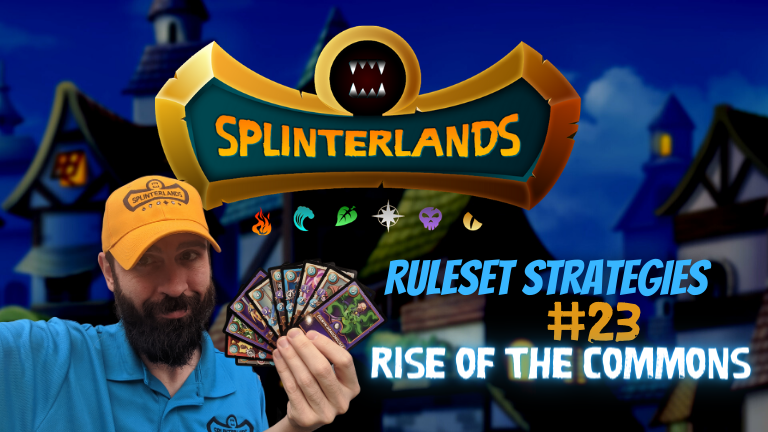
You may be surprised at how many incredible powerhouses there among the Common and Rare cards of Splinterlands. I've always said that I prefer leveling these cards up first. They may be more common now, but considering how many combined BCX it takes to get to the max levels, they won't be as common for long. Follow my lead and you'll be prepared to destroy your enemies in one of my favorite rulesets: Rise of the Commons!
Rise of the Commons
This Game is Balanced

The common misconception (see what I did there?) is that Commons and Rares are not only more common, but weaker than Epic and Legendary cards. Let me stop that thinking early if I may, by explaining to you the need for various rarities among Splinterlands cards. Rarity was never meant to be proprtional to strength in any way.
What separates Legendaries from Commons? Typically, the main differences are lore-basedcharacters rather than types of monsters or warriors. For example, there are tons of Silvershield Warriors in the world of the Splinterlands, but there is only one Lord of Darkness.. The stats of the cards are all designed quite brilliantly by @yabapmatt to be balanced. Legendaries tend to more often be
You may notice that Legendary cards seem to be stronger than Common cards, but there are several reasons that it seems this way. First, Legendaries only have 4 levels on their journey from base to max, while Commons have 10. Within the growth of a Common card, the increases in strength and power are much more gradual, and therefore more difficult to notice. A Legendary may seem to have had an incredible boost from level 1 to level 2, but that's simply because it jumped 25% of the way to max, rather than the 10% of a Common.

Additionally, Legendary cards almost always have a higher mana cost. So while they seem that they may be exceedingly useful at lower level play, they'll often eat up a large chunk of your mana cap and not be able to carry all the weight on their own. That's why I would almost always rather have a full team of Commons and Rares than a sparse team of Legendaries. One card with a lot of abilities is never as powerful as several cards whose abilities work together. I find these combinations far more often when dealing with Common and Rare cards, which I must use exclusively in Rise of the Commons.
Commons are easier to Understand
The use-cases and strategies of Common cards are generally easier to understand than those of Legendaries. Each Common (and most Rares) have specific purposes, and they're usually limited to just a couple unique purposes per card.

Picking a team from only Common and Rare cards is both refreshing and relaxing. There aren't always dozens of intricate puzzle pieces that must be put together. Sometimes what matters most is that you pick the right cards for the situation. The simplicity of Rise of the Commons is the thing I love most about the ruleset. My Common cards can beat up your Common cards.
This ruleset is also great because it gives you a chance to see what your Commons and Rares can do when they're not distracted and overshadowed by a bunch of Epics and Legendaries on both teams. Maybe you're aching to see your Exploding Dwarf in some awesome infinite Trample action, but some superbuff Legendary always seems to stop him before he gets rolling. Or perhaps you'd like to know what it feels like to get your Vampire to 20 Health in an Equalizer battle. With Legendaries and Epics out of the picture, this ruleset is your chance.
Have Fun With It

My advice for this ruleset is pretty unconventional, but I think you'll like it. Use Rise of the Commons as an experimental battleground in which your Commons and Rares get to show off for one another. If you can simply maximize the abilities and buffs of the cards you use, you'll usually be able to win in Rise of the Commons. Still, without the Legendaries and Epics, there are less controllable strategic elements in play, so anything can happen.
You can get a good idea of the state of your Common and Rare collections by paying close attention to these battles. I personally do not have a huge collection of Legendary cards, but I have almost every single one of the Epics. It's nice to use this ruleset to get them out of the way so I can take stock in the more common cards I sometimes forget about. One fantastic thing to consider about these battles: You don't have to worry about any infuriating Legendary Summoners destroying your fun (Yodin Zaku, I'm looking at you, you cat-faced tool!)
Never forget that this game (like every game) is all about having fun. Sure, it can be rewarding, but never lose sight of the reason that you play games, or the unthinkable will happen: They'll stop being fun. I win almost every battle I face in Rise of the Commons, and I think that's mostly because I get excited to see it. Try to find some special enjoyment that shakes up your routine wherever you can. Sometimes that's all that's needed to clear your head and clench your victory.
Don't Overdo the Range Attacks

One mistake that I have noticed is pretty easy to make in this ruleset is using too many Range attackers. There is no shortage of Range attacks among the Common and Rare cards of Splinterlands, but I have noticed their placement requires a little more finesse in Rise of the Commons battling. The main reason for this is the fact that there's usually not a huge beefy Legendary tank who is able to hold off attacks for as long.
When your first position isn't as well defended (which can easily happen when you're forced to use only Commons and Rares), you'll find your cards cycling forward a lot faster than they may in a normal battle. This means that it's even more crucial to make sure that they're all attacking every round that they are alive. If you get stuck with a Range attacker in front, your team is as good as dead, unless they have the elusive Close Range ability or the Close Range ruleset is also in play.
I'd recommend only using a single high-powered Range attacker in Rise of the Commons, or two at the most. If you try for three, you'll almost always find that their attacks become wasted. When a Range attacker reaches the front it can be a devastating blow that reflects not only the loss of your final close range attacker, but your inability to cause any further damage to your enemy's team.

Some Cards I Like to Use
As always, here are a bunch of cards that I like to play in the Rise of the Commons ruleset. There are tons of right answers and there are multiple solutions to every problem in Splinterlands, which is why most of us love the game as much as we do. I'm not professing that these cards are the be all end all of this ruleset. In fact, they're probably not the best by anyone's standards other than mine. My purpose here is to get you thinking strategically about how to maximize your own drafting ability when working with Rise of the Commons. If you have better ideas of cards that I haven't mentioned, I'd appreciate it if you'd share with the class by posting a comment below! We can all benefit from each other's knowledge.
Cerberus
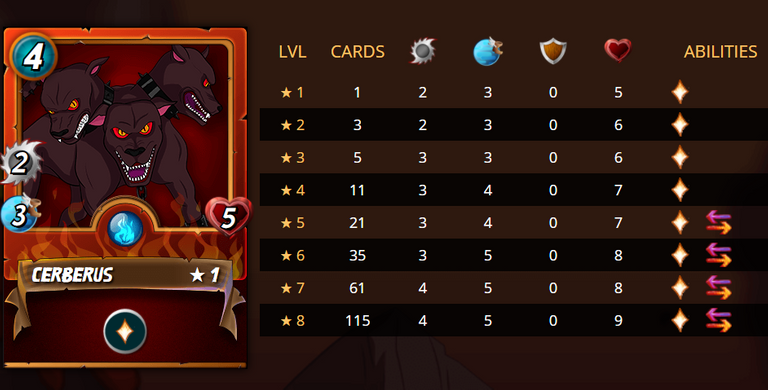
I love keeping it simple with everyone's favorite three-headed hell hound, Cerberus, especially in the Rise of the Commons ruleset. One great thing about this card is that it's very good at early levels as well as more advanced ones. I always recommend to new players starting out on level 1 to focus on attacks greater than 1 (check), low mana (check) and abilities like Healing (check) and Shield. So Cerberus may not have Shield, but he's pretty quick which makes him easy to miss in a Novice or Bronze battle. Then at level 5 and beyond, he gains the Retaliate ability, which when paired with Malric Inferno or Daria Dragonscale can be absolutely devastating. I think this Rare Beta card fits in perfectly with Rise of the Commons.
Electric Eels
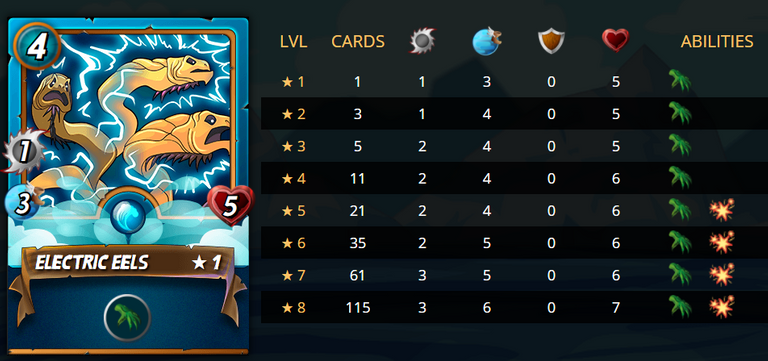
These eels are another Rare card that you will be glad to have handy in Rise of the Commons. Before level 5, they won't be quite as useful and there are probably better choices for beginners than this popular Promo edition card, but I use them quite often, especially when one of my favorites, the Manticore, is off the table. If you play at Gold League or higher, the level 5 Blast ability makes the Electric Eels one of my go-to Reach attackers, especially in the Rise of the Commons ruleset.
Stonesplitter Orc
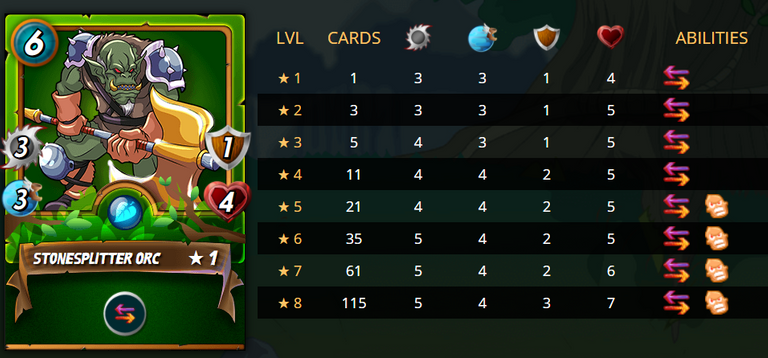
The Stonesplitter Orc is my favorite tank in the Earth Splinter. There aren't many rulesets that would prevent me from choosing this awesome card. Even right off the bat at level 1, the Orc has a Melee attack of 3, Armor, and the native Retaliate ability. Enrage at level 5 is like an unnecessary added bonus with this card. It may be a little pricey on the mana for a Rare card, but I think you'll find if you add the Stonesplitter to your collection that it's well worth the mana expense 90% of the time.
Lone Boatman
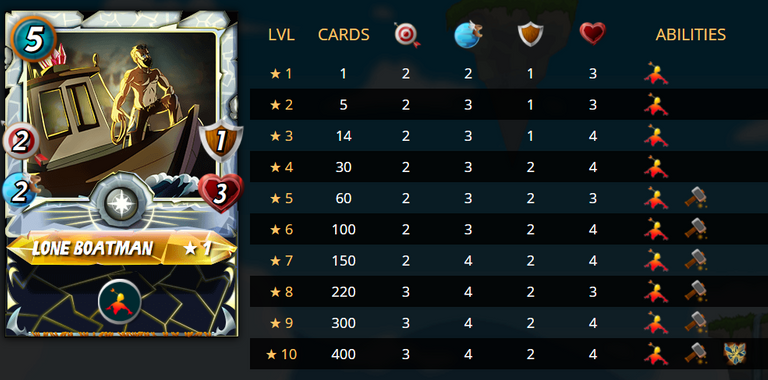
I try to recommend different cards for different rulesets whenever I can, but let's face it: A good card is a good card. You may have seen the Boatman in one or two of my recommendations before, but that's only because it's a fantastic and versatile card. Even before its level 5 addition of Repair (one of the best abilities in Splinterlands) it's a powerful Sniper for a very reasonable mana cost. To add the Repair ability, you only need to get the Boatman to level 5 for 60 BCX, and you can actually play at that level in the Silver League as long as you have a level 4 Rare Summoner. Having mine maxed, I also think that the icing on the cake ability of Shatter is well worth the additional 100 BCX required to get there, but you can probably do without it, even if you play at Diamond. For me, when it came to a card as useful as this one, maxing it out was a no brainer.
Contessa L'ament
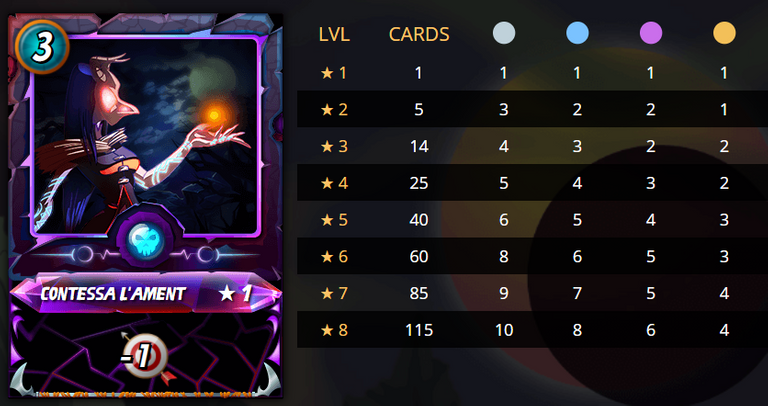
For my Death Splinter recommendation, I'm going with a Summoner this time. It's the creepy lady in the mask, the one and only Contessa L'ament. I think that this Rare Summoner's Range debuff is incredibly undervalued. I win more battles with this card than I ever won when I used to play with Zintar Mortalis. I've also noticed that she does especially well in low mana battles like those you'll face in the Little League Ruleset, as well as Rise of the Commons. I think the reason for this is that too many players will rely on powerful Range attacks in these battles simply because big attackers can be found in the Range category. As I described above, using too many Range attackers is something of a trap in this ruleset. If your enemy has fallen into this trap, you'll be victorious if you're using Contessa, especially if you've thrown the Blind or Return Fire abilities into the mix. Return Fire can be incredibly brutal against an over-Ranged team.
Drake of Arnak

Because of how heavily the Dragon Splinter is weighted toward Legendary and Epic cards, it difficult to recommend a Dragon card for Rise of the Commons. But with the Drake of Arnak you may find a perfect situation. He may cost 1 more mana than Camilla Sungazer, but his +1 Armor buff is still quite enticing. Don't think of it as a small increase to already existing Armor, but the addition of Armor to cards that were never meant to be protected in that way. Also consider this: The Repair ability only works when there is Armor to be repaired. Not as many cards have natural Armor as you might think, and with the Drake's buff, you can repair any of their Armor. At worst, this Armor gives each of your cards an extra hit from a Range or Melee attack. At best, it makes your tank unable to be killed through a carefully placed combination of Healing and Repair. Think about it. If your enemy is relying on a heavy-hitting tank without Piercing, you'll be able to fend off that attack every round while still tank-healing the damage from the back row Magic attackers. Consider the Drake, especially with the Fire Splinter, where there aren't a lot of cards with innate Armor.
Parasitic Growth
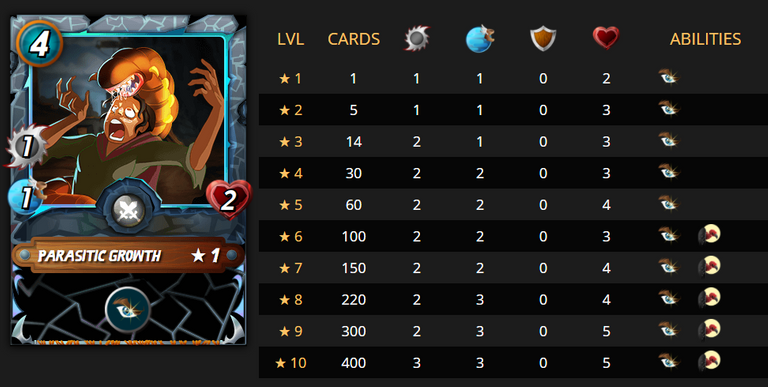
It may be disgusting, but the Parasitic Growth is a great Neutral Opportunity card that's very useful in the Rise of the Commons ruleset. It gains a Melee attack point at level 3 for only 14 BCX, and level 3 Commons can be played at the Bronze League level, so I'd recommend getting 14 of these worms as quickly as you can. If you are able to buff the attack power even more by using Malric inferno or the Inspire ability, your parasite will burrow through the brains of your enemy's whole back row, doing all the most difficult work for you. The next milestone after level 3 is of course level 6 at 100 BCX, when it gains the Scavenger ability. With that added ability, this card becomes a contender at max game play. But if you're in that deep with the parasite, you'll probably end up going all the way for that 3rd Melee attack point that can be found at the top.
There you have it! Hopefully, these strategy ramblings have given you some good stuff to think about for when you face the Rise of the Commons ruleset! Don't worry, your Legendaries and Epics are in a safe place, and you'll get them back when it's over. In the meantime, have fun with this awesome ruleset!
See you on the battlefield!

Previous Editions of the RuleSet Strategy Series
- Back to Basics
- Healed Out
- Heavy Hitters
- Silenced Summoners
- Aim True
- Super Sneak
- Melee Mayhem
- Keep Your Distance
- Weak Magic
- Up Close and Personal
- Lost magic
- Unprotected
- Target Practice
- Fog of War
- Armored Up
- Earthquake
- Reverse Speed
- Close Range
- Broken Arrows
- Equalizer
- Lost Legendaries
- Taking Sides
Splinterlands on Twitter
Splinterlore on Twitter
Splinterlands on Publish0x
Spliterlands Discord Community
Splinterlands Telegram Community
Subscribe to the GOLD FOIL PRESS

Play Town Star (Free)
Blog for rewards on Publish0x
Collect Doctor Who NFT Trading Cards